425. White-backed Mousebird Colius colius (Witkruismuisvoël)
Order: Coliiformes. Family: Coliidae
Description
It has a height of 34 cm, with the tail comprising approximately half the length. The upperparts, head, prominent crest and breast are grey; the lower back white, bordered with black; the rump maroon; the belly buff. The bill is bluish white with a black tip, and the legs and feet are coral pink. The eyes are brown. Sexes are alike in plumage and the males are slightly larger.
Paler than both the Speckled Mousebird and the Red-faced Mousebird, the other two mousebirds in its range. Greyer than Speckled Mousebird. Tail shorter and flight weaker than Red-faced Mousebird.
Distribution
It is near-endemic to southern Africa, occurring from south-western Angola to Namibia, western and central South Africa and southern Botswana in the arid and semi-arid regions.
Habitat
It generally prefers the area around rivers running through sparse woodland. It can also be found in farmyards, parks and orchards.
Diet
It exclusively feeds on plants, especially fruit but also leaves, shoots, flowers and nectar. It usually forages in trees, bushes and shrubs, rarely going down to the ground to pick up a fallen fruit.
Breeding
The White-backed mousebirds are monogamous. The nest is built by both sexes, consisting of a small, shallow bowl of twigs, leaves and grass. It is often lined with fluffy seeds, down and occasionally sheep's wool. Egg-laying season is year-round, peaking from September-October. It lays 1-6, usually 2-4 eggs, which are incubated by both sexes for 11-13 days. Once the chicks have hatched, the eggshells are trampled into the nest. The chicks are brooded non-stop from when they hatch to when they leave the nest. In captivity, the chicks stay in the nest for 11-20 days, becoming independent at about 21 days old.
Call
They communicate with sharp krik-krik vocalisations and a variety of other sounds, including a pleasant whistled zwee-wewit. Listen to Bird Call.
Status
Endemic; common resident.
Africa Wild Bird Book
White-backed Mousebird Photos
425. White-backed Mousebird Colius colius
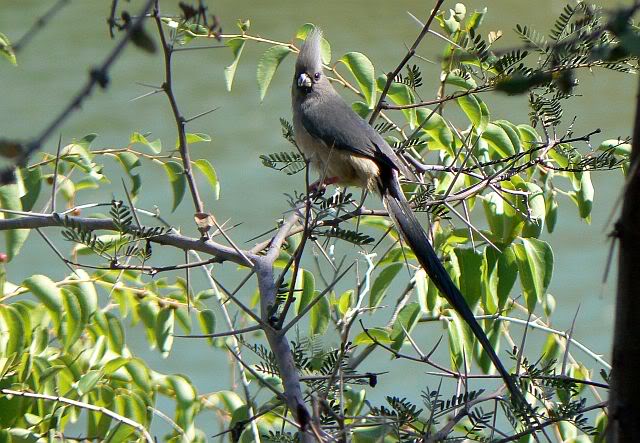
Richtersveld National Park
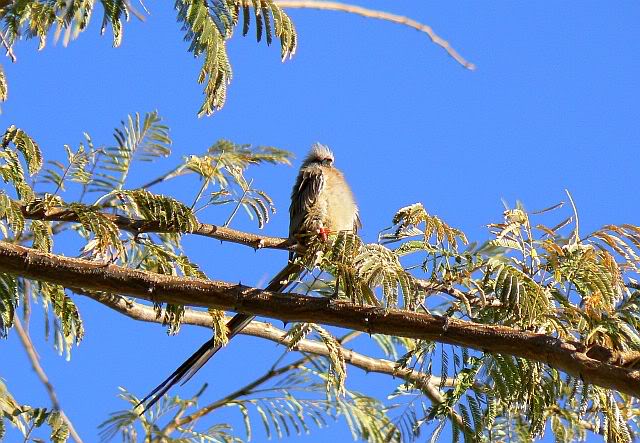
Upington
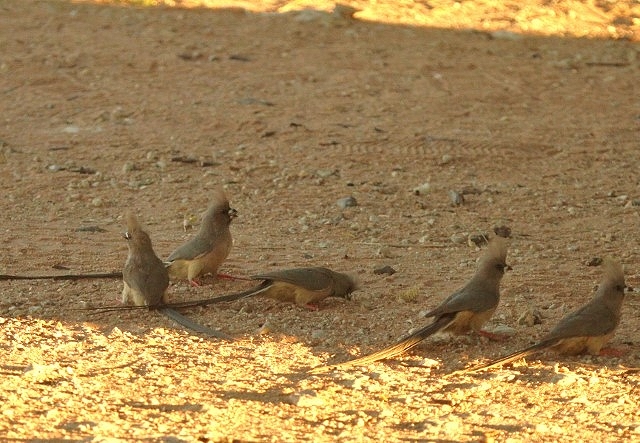 © nan
© nan
Kgalagadi Transfrontier Park

Karoo National Park © nan
Links:
Sabap2
Wikipedia
NEWMAN'S VOELS VAN SA (8ste UIT)

Richtersveld National Park

Upington
 © nan
© nanKgalagadi Transfrontier Park
Karoo National Park © nan
Links:
Sabap2
Wikipedia
NEWMAN'S VOELS VAN SA (8ste UIT)
Red-faced Mousebird
426. Red-faced Mousebird Urocolius indicus (Rooiwangmuisvoel)
Order: Coliiformes. Family: Coliidae
Description
Size 34 cm. This bird has a long tail comprising approximately half the birds total length. The crested head and breast are pale cinnamon with a red bill and eye mask. The red facial patch around the eyes is diagnostic. In flight, the grey rump contrasts slightly with the back and tail, which appear to be slightly suffused with green. Bluish-grey upperparts and tail; pale grey rump; white belly.
The birds usually fly in small parties, and have a fast, powerful and direct flight action.
The sexes are similar, but juveniles lack the crest and have a green mask, ear coverts buff. Bill greenish with dark tip and pink base.
Distribution
Occurs from southern Angola, Zambia and Malawi to southern Africa.
Habitat
Thornveld, open broad-leaved woodland, lowland fynbos and suburban gardens, avoiding forests, and extremely dry regions.
Diet
It is a frugivore. Its diet is dominated by fruit, supplemented with nectar, flowers and leaves. It typically forages in groups of 3-10, landing in trees and bushes to forage.
Breeding
Monogamous, sometimes cooperative breeder. These sedentary birds breed between June to February, peaking from September-November. The nest is a large untidy cup of plant material lined with material such as sheep wool, is built by both sexes. The breeding pair are assisted by helpers. Courtship involves preening and a 'bouncing display', in which one bird bounces up and down on its perch, the tempo increasing as its mate gets closer. It is typically placed 2-8 metres above ground, in a tree or shrub. It lays 1 to 7 eggs, which are incubated by both sexes and sometimes helpers, for 10 to 15 days. The chicks are brooded for the first few days of their life, sometimes by both adults at once. They stay in the nest for 14 to 20 days, after which they become fully independent.
Call
The Red-faced Mousebird has a whistled tsee-tee-tee call. Listen to Bird Call.
Status
Common resident. Locally nomadic with records of altitudinal movements in winter months.
Order: Coliiformes. Family: Coliidae
Description
Size 34 cm. This bird has a long tail comprising approximately half the birds total length. The crested head and breast are pale cinnamon with a red bill and eye mask. The red facial patch around the eyes is diagnostic. In flight, the grey rump contrasts slightly with the back and tail, which appear to be slightly suffused with green. Bluish-grey upperparts and tail; pale grey rump; white belly.
The birds usually fly in small parties, and have a fast, powerful and direct flight action.
The sexes are similar, but juveniles lack the crest and have a green mask, ear coverts buff. Bill greenish with dark tip and pink base.
Distribution
Occurs from southern Angola, Zambia and Malawi to southern Africa.
Habitat
Thornveld, open broad-leaved woodland, lowland fynbos and suburban gardens, avoiding forests, and extremely dry regions.
Diet
It is a frugivore. Its diet is dominated by fruit, supplemented with nectar, flowers and leaves. It typically forages in groups of 3-10, landing in trees and bushes to forage.
Breeding
Monogamous, sometimes cooperative breeder. These sedentary birds breed between June to February, peaking from September-November. The nest is a large untidy cup of plant material lined with material such as sheep wool, is built by both sexes. The breeding pair are assisted by helpers. Courtship involves preening and a 'bouncing display', in which one bird bounces up and down on its perch, the tempo increasing as its mate gets closer. It is typically placed 2-8 metres above ground, in a tree or shrub. It lays 1 to 7 eggs, which are incubated by both sexes and sometimes helpers, for 10 to 15 days. The chicks are brooded for the first few days of their life, sometimes by both adults at once. They stay in the nest for 14 to 20 days, after which they become fully independent.
Call
The Red-faced Mousebird has a whistled tsee-tee-tee call. Listen to Bird Call.
Status
Common resident. Locally nomadic with records of altitudinal movements in winter months.
PuMbAa
Please visit our website: www.photomaniacs.de
Please visit our website: www.photomaniacs.de
Red-faced Mousebird Photos
426. Red-faced Mousebird Urocolius indicus (Rooiwangmuisvoel)
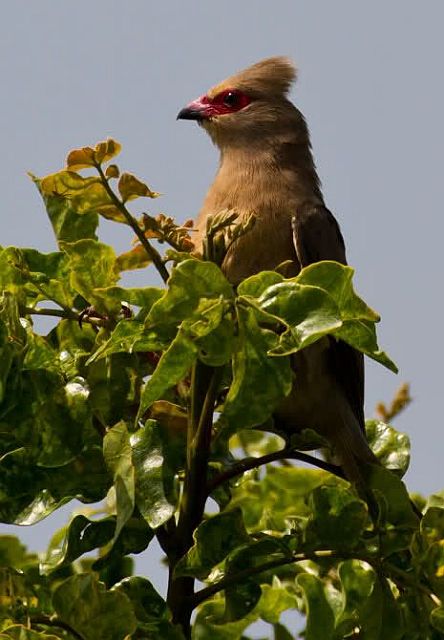
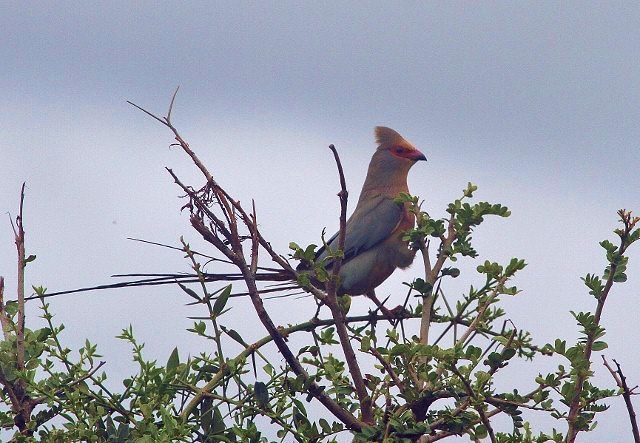 © nan
© nan
Links:
Species text Sabap1
Sabap
NEWMAN'S VOELS VAN SA (8ste UIT)

 © nan
© nanLinks:
Species text Sabap1
Sabap
NEWMAN'S VOELS VAN SA (8ste UIT)
PuMbAa
Please visit our website: www.photomaniacs.de
Please visit our website: www.photomaniacs.de
ORDER TROGONIFORMES Family Trogonidae (Trogons)
The trogons and quetzals are birds in the order Trogoniformes which contains only one family, the Trogonidae. The family contains 39 species in seven genera. They might constitute a member of the basal radiation of the order Coraciiformes or closely related to mousebirds and owls. The word "trogon" is Greek for "nibbling" and refers to the fact that these birds gnaw holes in trees to make their nests.
Trogons are residents of tropical forests worldwide. The greatest diversity is in the Neotropics, where four genera, containing 24 species occur. The genus Apaloderma contains the three African species. The genera Harpactes and Apalharpactes, containing twelve species, are found in southeast Asia. The Narina Trogon of Africa is slightly exceptional in that it utilises a wider range of habitats than any other trogon, ranging from dense forest to fairly open savannah, and from the Equator to southern South Africa. It is the most widespread and successful of all the trogons.
They feed on insects and fruit, and their broad bills and weak legs reflect their diet and arboreal habits. Although their flight is fast, they are reluctant to fly any distance. Trogons are generally not migratory, although some species undertake partial local movements.
The trogons as a family are fairly uniform in appearance, having compact bodies and long tails and short necks. Their legs and feet are weak and short, and trogons are essentially unable to walk beyond a very occasional shuffle along a branch. They are even incapable of turning around on a branch without using their wings. The ratio of leg muscle to body weight in trogons is only 3 percent, the lowest known ratio of any bird. The arrangement of toes on the feet of trogons is also unique amongst birds, although essentially resembling the zygodactyl’s two forward two backward arrangement of parrots and other near-passerines, the actual toes are arranged with usually inner hallux being the outer hind toe, an arrangement that is referred to as heterodactylous. The strong bill is short and the gape wide, particularly in the fruit eating quetzals, with a slight hook at the end. There is also a notch at the end of the bill and many species have slight serrations in the mandibles. The skin is exceptionally tender, making preparation of study skins difficult for museum curators. Trogons have soft, often colourful, feathers with distinctive male and female plumage. The African trogons are generally green on the back with red bellies. The wings are short but strong, with the wing muscle ratio being around 22% of the body weight. In spite of the strength of their flight, trogons do not fly often or for great distances, generally flying no more than a few hundred metres at a time. Only the montane species tend to make long distance flights. Shorter flights tend to be direct and swift, but longer flights are slightly undulating. Their flight can be surprisingly silent (for observers), although that of a few species is reportedly quite noisy.
The trogons are insectivorous, usually hunting from a perch. They nest in holes dug into trees, laying 2–4 white or pastel-coloured eggs.
Trogons are residents of tropical forests worldwide. The greatest diversity is in the Neotropics, where four genera, containing 24 species occur. The genus Apaloderma contains the three African species. The genera Harpactes and Apalharpactes, containing twelve species, are found in southeast Asia. The Narina Trogon of Africa is slightly exceptional in that it utilises a wider range of habitats than any other trogon, ranging from dense forest to fairly open savannah, and from the Equator to southern South Africa. It is the most widespread and successful of all the trogons.
They feed on insects and fruit, and their broad bills and weak legs reflect their diet and arboreal habits. Although their flight is fast, they are reluctant to fly any distance. Trogons are generally not migratory, although some species undertake partial local movements.
The trogons as a family are fairly uniform in appearance, having compact bodies and long tails and short necks. Their legs and feet are weak and short, and trogons are essentially unable to walk beyond a very occasional shuffle along a branch. They are even incapable of turning around on a branch without using their wings. The ratio of leg muscle to body weight in trogons is only 3 percent, the lowest known ratio of any bird. The arrangement of toes on the feet of trogons is also unique amongst birds, although essentially resembling the zygodactyl’s two forward two backward arrangement of parrots and other near-passerines, the actual toes are arranged with usually inner hallux being the outer hind toe, an arrangement that is referred to as heterodactylous. The strong bill is short and the gape wide, particularly in the fruit eating quetzals, with a slight hook at the end. There is also a notch at the end of the bill and many species have slight serrations in the mandibles. The skin is exceptionally tender, making preparation of study skins difficult for museum curators. Trogons have soft, often colourful, feathers with distinctive male and female plumage. The African trogons are generally green on the back with red bellies. The wings are short but strong, with the wing muscle ratio being around 22% of the body weight. In spite of the strength of their flight, trogons do not fly often or for great distances, generally flying no more than a few hundred metres at a time. Only the montane species tend to make long distance flights. Shorter flights tend to be direct and swift, but longer flights are slightly undulating. Their flight can be surprisingly silent (for observers), although that of a few species is reportedly quite noisy.
The trogons are insectivorous, usually hunting from a perch. They nest in holes dug into trees, laying 2–4 white or pastel-coloured eggs.
Family Trogonidae (Trogons) Index
ORDER TROGONIFORMES
Family Trogonidae (Trogons)
Apaloderma narina Narina Trogon 427
Apaloderma vittatum Bar-tailed Trogon
Family Trogonidae (Trogons)
Apaloderma narina Narina Trogon 427
Apaloderma vittatum Bar-tailed Trogon
- Lisbeth
- Site Admin
- Posts: 65591
- Joined: Sat May 19, 2012 12:31 pm
- Country: Switzerland
- Location: Lugano
- Contact:
Narina Trogon
427. Narina Trogon Apaloderma narina (Bosloeri)
Order: Trogoniformes. Family: Trogonidae
Description
Lentgh 29-34 cm, weight 67 g. Male is vivid green above with a green throat and upper breast, startling red belly, and a blue-green tail with white outertail feathers (tail looks all white from underneath). The bill is pale yellow; small patches of bare skin on the upper eyelids, cheek and base of the bill may be bright yellow (non-breeding) or pale turquoise (breeding).
The female has a brown face, purplish green plumage, blue circle around each eye and duller red below. The upper breast is rufous to grey.
Distribution
Across much of sub-Saharan Africa; within southern Africa it is locally common in the Caprivi Strip (Namibia), northern Botswana, Zimbabwe, Mozambique and eastern and southern South Africa. Typical of trogon species, the Narina trogon favours forest or woodland habitat, and occurs in any such suitable habitat from the Western Cape all along the eastern seaboard to Mozambique, and along the Limpopo and Mpumalanga escarpment.

Habitat
Riverine and evergreen forests and dense, broad-leaved woodland.
Diet
It feeds mainly on invertebrates, such as caterpillars, spiders and mantids, rarely supplemented with small reptiles. It hunts by sitting motionlessly on a perch, occasionally moving its head side to side and up and down, looking for prey. Once prey is located, it rapidly grabs it before returning to its perch.
Breeding
A monogamous, solitary nester, with very strong pair bonds. Courtship is highly elaborate, with a 'floating lek', in which 3-7 males gather together to aerially chase each other, while the females pick out their mates. This display is followed by more courtship displays which last a few more days. In this period the pair locate their nest site. It nests in natural cavities in trees. Egg-laying season is from November-February. It lays 2-4 eggs, which are incubated by both sexes for 16-21 days. The chicks are fed mainly by the male. The chicks are brooded in the early stages of their life, leaving the nest after about 25-28 days. They remain with the parents for months after fledging, even when they are able to get their own food.
Call
Male gives series of growling hoots hroo-hoo, hroo-hoo, hroo-hoo, rising to a crescendo. Listen to Bird Call.
Status
Fairly common resident.
Order: Trogoniformes. Family: Trogonidae
Description
Lentgh 29-34 cm, weight 67 g. Male is vivid green above with a green throat and upper breast, startling red belly, and a blue-green tail with white outertail feathers (tail looks all white from underneath). The bill is pale yellow; small patches of bare skin on the upper eyelids, cheek and base of the bill may be bright yellow (non-breeding) or pale turquoise (breeding).
The female has a brown face, purplish green plumage, blue circle around each eye and duller red below. The upper breast is rufous to grey.
Distribution
Across much of sub-Saharan Africa; within southern Africa it is locally common in the Caprivi Strip (Namibia), northern Botswana, Zimbabwe, Mozambique and eastern and southern South Africa. Typical of trogon species, the Narina trogon favours forest or woodland habitat, and occurs in any such suitable habitat from the Western Cape all along the eastern seaboard to Mozambique, and along the Limpopo and Mpumalanga escarpment.

Habitat
Riverine and evergreen forests and dense, broad-leaved woodland.
Diet
It feeds mainly on invertebrates, such as caterpillars, spiders and mantids, rarely supplemented with small reptiles. It hunts by sitting motionlessly on a perch, occasionally moving its head side to side and up and down, looking for prey. Once prey is located, it rapidly grabs it before returning to its perch.
Breeding
A monogamous, solitary nester, with very strong pair bonds. Courtship is highly elaborate, with a 'floating lek', in which 3-7 males gather together to aerially chase each other, while the females pick out their mates. This display is followed by more courtship displays which last a few more days. In this period the pair locate their nest site. It nests in natural cavities in trees. Egg-laying season is from November-February. It lays 2-4 eggs, which are incubated by both sexes for 16-21 days. The chicks are fed mainly by the male. The chicks are brooded in the early stages of their life, leaving the nest after about 25-28 days. They remain with the parents for months after fledging, even when they are able to get their own food.
Call
Male gives series of growling hoots hroo-hoo, hroo-hoo, hroo-hoo, rising to a crescendo. Listen to Bird Call.
Status
Fairly common resident.
"Education is the most powerful weapon which you can use to change the world." Nelson Mandela
The desire for equality must never exceed the demands of knowledge
The desire for equality must never exceed the demands of knowledge
- Lisbeth
- Site Admin
- Posts: 65591
- Joined: Sat May 19, 2012 12:31 pm
- Country: Switzerland
- Location: Lugano
- Contact:
Narina Trogon Photos
427. Narina Trogon Apaloderma narina
 © Tina
© Tina
iSimangaliso
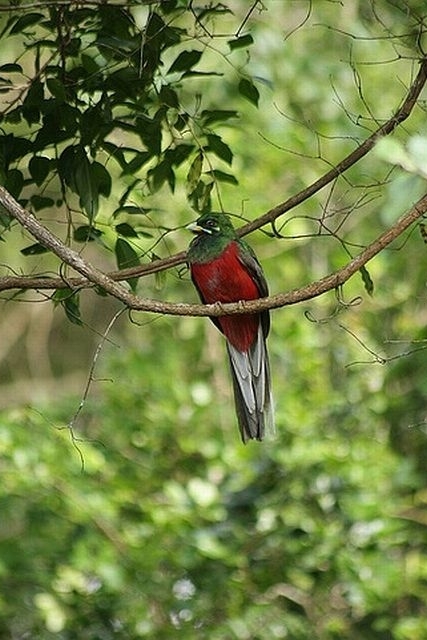 © flying cheetah
© flying cheetah
Male, iSimangaliso
Links:
Species text Sabap1
Sabap2
Birds of Botswana
Roberts online
 © Tina
© TinaiSimangaliso
 © flying cheetah
© flying cheetahMale, iSimangaliso
Links:
Species text Sabap1
Sabap2
Birds of Botswana
Roberts online
"Education is the most powerful weapon which you can use to change the world." Nelson Mandela
The desire for equality must never exceed the demands of knowledge
The desire for equality must never exceed the demands of knowledge
ORDER CORACIIFORMES
The Coraciiformes are a group of usually colorful near passerine birds including the kingfishers, the bee-eaters, the rollers. They generally have syndactyly, with three forward-pointing toes (and toes 3 & 4 fused at their base), though in many kingfishers one of these is missing.
This is largely an Old World order. The species that belong to this group vary greatly in size. Some members of this group are solitary birds while others form large colonies. Bee-eaters are gregarious and nest in dense groups. They thus enjoy the protection from predators that large groups offer, with so many eyes on the lookout for danger.
Most kingfishers and their relatives employ a hunting technique referred to as "spot-and swoop" and which consists of the bird siting atop a favorite perch waiting to spot their prey. When prey stumbles into range, the bird swoops down to capture their quarry and then returns to the perch for the kill. They beat the prey against the branch to disable it before eating it or returning to the nest to feed their young. Bee-eaters, which feed primarily on bees, rub the insect against the branch to discharge the stinger before making a meal of the bee.
Kingfishers and their relatives have a large head in relation to the rest of their body. Most have rounded wings with the exception of bee-eaters whose wings are pointed. Their pointed wings enable them to maneuver mid-air with great agility, a skill that helps them to capture their flying insect prey. Many species are brightly colored and all have feet with three forward-pointing toes and one backward pointing toe.
Kingfishers and their relatives nest in tree holes or dig tunnels into banks of dirt such as those that line the edges of rivers. Hornbills exhibit the unique behavior of sealing the female and eggs in the cavity of a tree, using mud to plaster the hole nearly shut. A small opening is left to enable the male to pass food to the female and young. Kingfishers and their relatives lay as many as 10 eggs when they breed and when their young hatch they are blind and featherless.
ORDER CORACIIFORMES
Family Coraciidae (Rollers)
Family Alcedinidae (Kingfishers)
Family Meropidae (Bee-eaters)
This is largely an Old World order. The species that belong to this group vary greatly in size. Some members of this group are solitary birds while others form large colonies. Bee-eaters are gregarious and nest in dense groups. They thus enjoy the protection from predators that large groups offer, with so many eyes on the lookout for danger.
Most kingfishers and their relatives employ a hunting technique referred to as "spot-and swoop" and which consists of the bird siting atop a favorite perch waiting to spot their prey. When prey stumbles into range, the bird swoops down to capture their quarry and then returns to the perch for the kill. They beat the prey against the branch to disable it before eating it or returning to the nest to feed their young. Bee-eaters, which feed primarily on bees, rub the insect against the branch to discharge the stinger before making a meal of the bee.
Kingfishers and their relatives have a large head in relation to the rest of their body. Most have rounded wings with the exception of bee-eaters whose wings are pointed. Their pointed wings enable them to maneuver mid-air with great agility, a skill that helps them to capture their flying insect prey. Many species are brightly colored and all have feet with three forward-pointing toes and one backward pointing toe.
Kingfishers and their relatives nest in tree holes or dig tunnels into banks of dirt such as those that line the edges of rivers. Hornbills exhibit the unique behavior of sealing the female and eggs in the cavity of a tree, using mud to plaster the hole nearly shut. A small opening is left to enable the male to pass food to the female and young. Kingfishers and their relatives lay as many as 10 eggs when they breed and when their young hatch they are blind and featherless.
ORDER CORACIIFORMES
Family Coraciidae (Rollers)
Family Alcedinidae (Kingfishers)
Family Meropidae (Bee-eaters)
Family Coraciidae (Rollers) Index
The rollers are an Old World family, Coraciidae, of near passerine birds. The group gets its name from the aerial acrobatics some of these birds perform during courtship or territorial flights.
Rollers resemble crows in size and build, ranging from 25 to 27 cm in length. They share the colourful appearance of kingfishers and bee-eaters, blues and pinkish or cinnamon browns predominating. The rollers are similar in general morphology to their relatives in the order Coraciiformes, having large heads on short necks, bright plumage, weak feet and short legs. The two inner front toes are connected, but not the outer one. The weakness of the feet and legs is reflected in their behaviour, rollers do not hop or move along perches and seldom use their feet other than for occasional lurching leaps along the ground pursuing escaping prey. The bill is robust, and is shorter yet broader in the genus Eurystomus, sometimes known as the broad-billed rollers. The broad-billed rollers have brightly coloured bills, whereas those of the Coracias (or true) rollers are black. Other differences between the two genera are in wing length; the more aerial Eurystomus rollers have longer wings (and shorter feet still) than the Coracias rollers, this reflects differences in their foraging ecology. Their calls are "repeated short, gruff caws".
The rollers are found in warmer parts of the Old World. Africa has most species, and is believed to be where the family originated. The European Roller is completely migratory, breeding in Europe and wintering in Africa. Other species are sedentary or short-range migrants.
These are birds of open habitats with trees or other elevated perches from which to hunt.
Rollers are noisy and aggressive when defending their nesting territories, which they patrol while displaying their striking plumage. Intruders are attacked with intimidating rolling dives. They are monogamous and nest in an unlined hole in a tree or in masonry, and lay 2–4 eggs in the tropics, 3–6 at higher latitudes. The eggs, which are white, hatch after 17–20 days, and the young remain in the nest for approximately another 30 days. Egg laying is staggered at one-day intervals so that if food is short only the older larger nestlings get fed. The chicks are naked, blind and helpless when they hatch.
Coracias rollers are watch-and wait hunters. they sit in a tree or on a post before descending on their prey and carrying it back to a perch in the beak before dismembering it. They take a wide range of terrestrial invertebrates, and small vertebrates such as frogs, lizards rodents and young birds. They will take items avoided by many other birds, such as hairy caterpillars, insects with warning colouration and snakes.
Eurystomus rollers hunt on the wings, swooping on flying beetles, crickets and other insects which are crushed by their broad deep beaks and eaten on the wing.
Links:
Africa Wild: Rollers - Bird of the Month: December 2012
Family Coraciidae (Rollers)
Coracias naevius Purple Roller 449
Coracias spatulatus Racket-tailed Roller 448
Coracias caudatus Lilac-breasted Roller 447
Coracias garrulus European Roller 446
Eurystomus glaucurus Broad-billed Roller 450
Rollers resemble crows in size and build, ranging from 25 to 27 cm in length. They share the colourful appearance of kingfishers and bee-eaters, blues and pinkish or cinnamon browns predominating. The rollers are similar in general morphology to their relatives in the order Coraciiformes, having large heads on short necks, bright plumage, weak feet and short legs. The two inner front toes are connected, but not the outer one. The weakness of the feet and legs is reflected in their behaviour, rollers do not hop or move along perches and seldom use their feet other than for occasional lurching leaps along the ground pursuing escaping prey. The bill is robust, and is shorter yet broader in the genus Eurystomus, sometimes known as the broad-billed rollers. The broad-billed rollers have brightly coloured bills, whereas those of the Coracias (or true) rollers are black. Other differences between the two genera are in wing length; the more aerial Eurystomus rollers have longer wings (and shorter feet still) than the Coracias rollers, this reflects differences in their foraging ecology. Their calls are "repeated short, gruff caws".
The rollers are found in warmer parts of the Old World. Africa has most species, and is believed to be where the family originated. The European Roller is completely migratory, breeding in Europe and wintering in Africa. Other species are sedentary or short-range migrants.
These are birds of open habitats with trees or other elevated perches from which to hunt.
Rollers are noisy and aggressive when defending their nesting territories, which they patrol while displaying their striking plumage. Intruders are attacked with intimidating rolling dives. They are monogamous and nest in an unlined hole in a tree or in masonry, and lay 2–4 eggs in the tropics, 3–6 at higher latitudes. The eggs, which are white, hatch after 17–20 days, and the young remain in the nest for approximately another 30 days. Egg laying is staggered at one-day intervals so that if food is short only the older larger nestlings get fed. The chicks are naked, blind and helpless when they hatch.
Coracias rollers are watch-and wait hunters. they sit in a tree or on a post before descending on their prey and carrying it back to a perch in the beak before dismembering it. They take a wide range of terrestrial invertebrates, and small vertebrates such as frogs, lizards rodents and young birds. They will take items avoided by many other birds, such as hairy caterpillars, insects with warning colouration and snakes.
Eurystomus rollers hunt on the wings, swooping on flying beetles, crickets and other insects which are crushed by their broad deep beaks and eaten on the wing.
Links:
Africa Wild: Rollers - Bird of the Month: December 2012
Family Coraciidae (Rollers)
Coracias naevius Purple Roller 449
Coracias spatulatus Racket-tailed Roller 448
Coracias caudatus Lilac-breasted Roller 447
Coracias garrulus European Roller 446
Eurystomus glaucurus Broad-billed Roller 450


